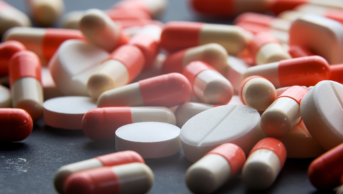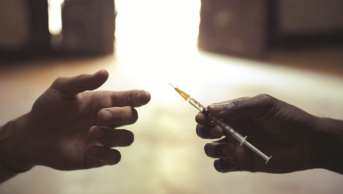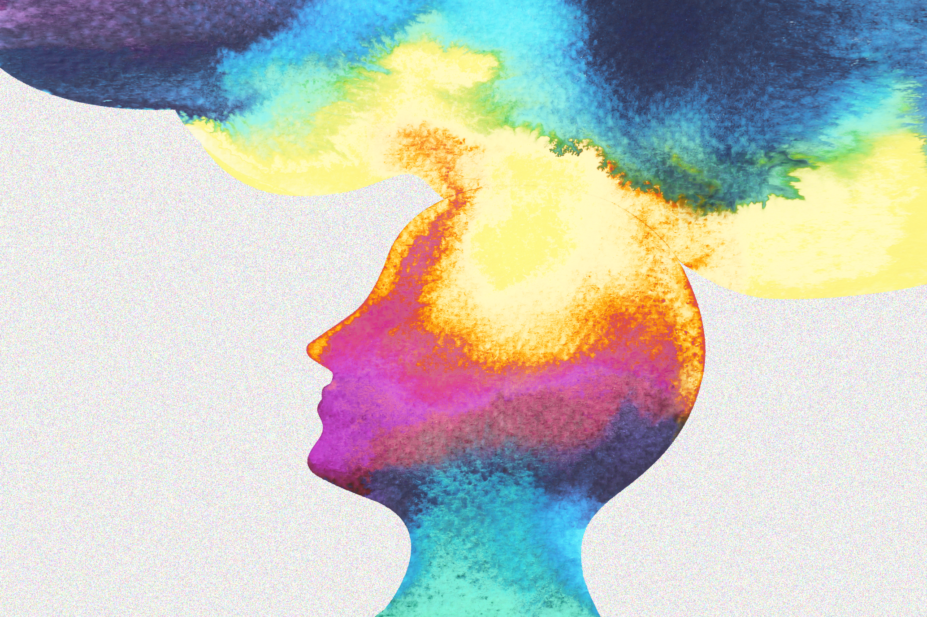
Shutterstock
On 4 July 2014, the people of South Carolina were celebrating Independence Day. But Jonathan Lubecky, a veteran of the Iraq War, was unable to join in with his neighbours because he was suffering from severe post-traumatic stress disorder (PTSD). “Where I live, they love fireworks, so my whole neighbourhood turns into Baghdad,” he says. That particular night, his now wife walked into the closet in their bedroom to find Lubecky wearing his body armour, with his service dog, having flashbacks.
In the eight years since returning from Iraq, Lubecky had tried to commit suicide five times and was taking 42 pills per day to control his depression, suicidal ideation and symptoms of PTSD. But by the following year’s Independence Day, despite the booming of fireworks, Lubecky was out on his porch. This time, he was “annoyed and … a little bit triggered” but more angry, rather than in the non-functional state he had been in the year before.
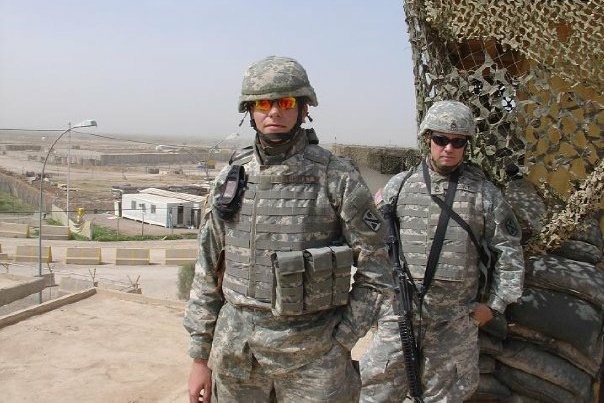
Source: Courtesy of Jonathan Lubecky
Jonathan Lubecky (left) in Iraq in 2006
The “miracle” that changed his life, as Lubecky describes it, is 3,4-methylenedioxymethamphetamine (MDMA), commonly known as the recreational drug ecstasy. Lubecky participated in a study using MDMA-assisted psychotherapy sessions to treat PTSD. After taking part in the trial his suicidal ideation was “eliminated”, his depression subsided by 40% and is now 70% gone, and his symptoms of PTSD reduced by 50%.
Lubecky is one of 26 veterans, police officers and firefighters who received MDMA for their moderate-to-severe PTSD in a 2018 study run by Michael Mithoefer, a psychotherapist and clinical researcher at the Medical University of South Carolina, and his wife Ann, a nurse. One month after the final MDMA session, 68% of the patients who received an active dose no longer met the criteria for PTSD[1]
.
Knowing what we know about MDMA, there could be tremendous implications for psychotherapy
This was the second trial conducted by the Mithoefers and overall the sixth phase II trial to use MDMA to treat PTSD — the others being conducted in the United States, Canada, Israel and Switzerland. After the success of the Mithoefers’s second trial, the US Food and Drug Administration (FDA) gave the drug breakthrough status and a phase III trial has just started. “The phase II trials have been very encouraging,” says Michael Mithoefer. This has buoyed other psychiatrists too, who are now investigating MDMA-assisted psychotherapy to treat different illnesses, such as alcohol addiction and social anxiety in adults with autism (see Panel 1). Alicia Danforth, a clinical psychologist at the University of California, San Francisco, says “knowing what we know about MDMA, there could be tremendous implications for psychotherapy”.
Early research
MDMA was first synthesised in 1912 by a German chemist working for the pharmaceutical company Merck. The company patented it in 1914 but never investigated the compound[2]
. Decades later, psychologists and therapists began to take an interest in MDMA for its ‘feeling enhancing and non-hallucinatory properties’ and, between 1977 and 1985, several case studies were published using the drug to facilitate psychotherapy sessions[3]
.
Because of the political and cultural turmoil … for a couple of decades all research [into psychedelics] was shut down
MDMA is loosely categorised as a psychedelic, although many of its features are unique. Chemically, it has structural similarities to both the psychedelic mescaline and the stimulant amphetamine. Charles Grob, a psychiatrist at Harbor-UCLA Medical Centre in Los Angeles, California, who has completed two studies with MDMA, became acquainted with psychedelic research in the 1970s and says it persuaded him that this class of drug should be of great interest to mental health professionals.But MDMA was banned in the UK in 1977 and in 1985 in the United States. It was given Schedule 1 status in both countries, meaning that it is classified as a drug of abuse with no medical applications, which made researching it difficult and costly. “Because of the political and cultural turmoil … for a couple of decades all research [into psychedelics] was shut down,” says Grob.
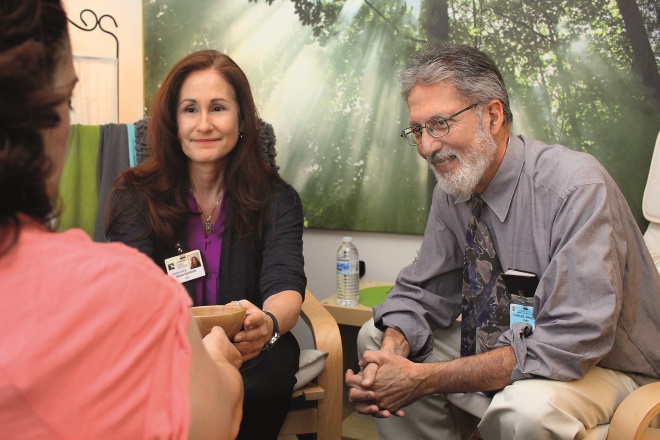
Source: Courtesy of Alicia Danforth
Charles Grob, a psychiatrist at Harbor-UCLA Medical Centre, Los Angeles, California, and Alicia Danforth, a clinical psychologist at the University of California, San Francisco, California, have completed a pilot study looking at the potential of MDMA to treat social anxiety in adults with autism
As the years went by, Grob, along with Mithoefer, saw an opening in the regulatory landscape and started to apply for permission to work with MDMA. It seemed like an ideal candidate to use for psychotherapy, “particularly this notion that patients remain alert, oriented, tapped into their feelings and able to articulate and achieve insight”, says Grob. In 1998, he published the first phase I study administering MDMA to healthy volunteers, which established “good safety parameters”.
Shortly after, in 2001, Mithoefer applied for permission to use MDMA for the first time to treat PTSD caused by sexual assault, abuse or violence in a phase II trial. He had spent many years treating patients with PTSD and recognised that there was a “large percentage of people we just couldn’t help with existing therapies”.
Current treatment for PTSD entails psychotherapy alongside taking an antidepressant — commonly a selective serotonin reuptake inhibitor, an anxiolytic and a sedative. Mithoefer explains: “We realised a long time ago that although some medications could be useful for treating PTSD symptoms, the definitive treatment is psychotherapy.” This treatment path is recommended in international guidelines, including those from the National Institute for Health and Clinical Excellence. But even with gold-standard treatment, between 25% and 50% of people do not respond[4]
.
When I was doing regular therapy I wouldn’t talk about the trauma because … I felt like I was back there again, my body would react like it did when the trauma first occurred
For these people, it seems that psychotherapy does not work because they are too traumatised to fully participate. “As soon as they’re asked to reflect on the traumatic memory, they are so overwhelmed with negative affect that they dissociate and they can’t do the trauma process work,” explains Ben Sessa, a psychiatrist working in Bristol, UK. Lubecky, who had psychotherapy for eight years before taking part in the MDMA trial, says that “when I was doing regular therapy I wouldn’t talk about the trauma because … I felt like I was back there again, my body would react like it did when the trauma first occurred”.
Mithoefer explains the theory was that MDMA would stop people from being overwhelmed and help “overcome the obstacles to successful therapy”. But there was a delay in beginning this first phase II trial, which was only published in 2010, because of what turned out to be false claims about MDMA’s toxicity in primates[5]
.
Phase II trials
When the results from the study were eventually published, they showed that, of the 12 people given MDMA, 10 (83.3%) no longer met the criteria for PTSD at the end of the study compared with 2 out of 8 patients (25%) in the placebo group. As an additional benefit, all three subjects who were unable to work on account of PTSD returned to employment[4]
.
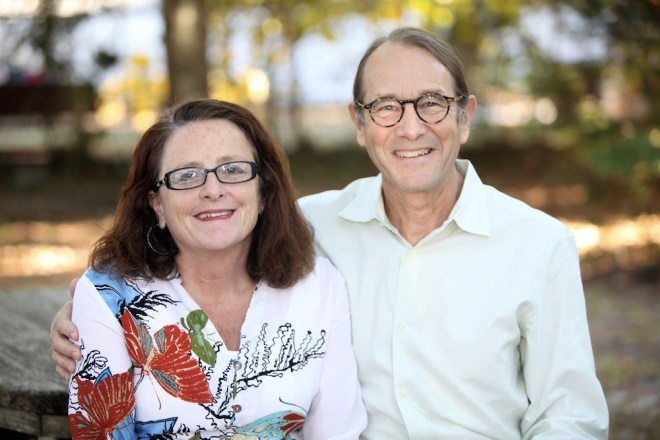
Source: Courtesy of Multidisciplinary Association for Psychedelic Studies
Michael Mithoefer, a psychotherapist and clinical researcher at the Medical University of South Carolina, and his wife Ann Mithoefer, a nurse, conducted a trial of MDMA-assisted psychotherapy in war veterans with PTSD
Mithoefer says that, since these data have been published, there has been a “very striking change” in attitude towards MDMA and the public seem to be more educated now. It was the strength of the first phase II results that prompted the other five studies, including the 2018 one, which have all returned “strong results”, says Mithoefer. While his first trial involved survivors of sexual assault and violence, research suggested war-related PTSD is harder to treat and so his 2018 study recruited veterans and emergency workers, including Lubecky.
Patients came to the trial through word of mouth or referral from a mental health professional. Lubecky says that he only found out about it when his psychiatrist’s intern told him to google “MDMA PTSD”. At this point he had tried to commit suicide so many times that he says he had nothing to lose, so he called the Mithoefers. Like all participants he was required to undergo a physical examination and baseline assessment before enrolling in the study. This is primarily to exclude patients with prior cardiovascular disease because MDMA can elevate blood pressure, explains Mithoefer. Participants are also required to taper off their normal medicines owing to concerns about drug interactions.
We don’t believe MDMA is something you should be able to pick up at the pharmacy and take home
Each participant is carefully prepared for the trial with three psychotherapy sessions, each 90 minutes long, before they take any MDMA. On the day that patients take the drug, they attend the Mithoefers’s medical practice, which is in a converted house. Despite being hooked up to a blood pressure and temperature monitor, Lubecky says the environment is “comfortable”, with a real bed to relax on.
Mithoefer stresses that “we don’t believe [MDMA is] something you should be able to pick up at the pharmacy and take home”, it should only be given through licensed clinics. The study also confirmed that the potential for abuse of MDMA following clinical use is low. Of 26 participants, 6 had previously taken MDMA between two and five times. In the 12 months following treatment, two participants who had previously taken MDMA took it again, but none of those who were new to the drug did so[1]
.
MDMA-assisted psychotherapy was like doing therapy and feeling like you’re being hugged by everyone on the planet who loves you, and a load of puppies are licking your face
In contrast to recreational MDMA, the MDMA used in the study had to meet high standards of purity and consistency. It was given in capsule form and neither the researchers nor the patient knew whether it was the 30mg active placebo, the 75mg dose or the 125mg dose (125mg is considered one dose recreationally), which was followed by a 50% booster dose a few hours in. When Lubecky took the MDMA for the first time, he says he was expecting “it was going to be like in [the film] The Matrix — red pill, blue pill, kind of thing” but then nothing happened until about 40 minutes later. Once it kicked in, the therapist started asking him questions such as “what’s the weather like in Iraq”. Mithoefer explains that the therapists always discuss the trauma but they “don’t dictate”.
Compared with previous therapy, Lubecky says he was “in such a safe place with the MDMA”. “I was able to just talk about things I had never talked about before without having a physical response to it,” he adds. He refers to the experience as “doing therapy and feeling like you’re being hugged by everyone on the planet who loves you, and a load of puppies are licking your face”.
Pharmacology
Lubecky is describing the myriad effects that MDMA has on the brain caused by its action at multiple receptor sites. It exerts an effect through the 5HT1A and 1B receptors, therefore stimulating the release of serotonin, which reduces anxiety and depression and causes mood-elevating effects. In addition, it has a mild psychedelic effect; nothing like as intense as classical hallucinogens, such as LSD, says Sessa, but enough to provide for an “extra level of creativity so that you can see things in a new light”.

Source: Courtesy of Ben Sessa
Ben Sessa, a psychiatrist working in Bristol, UK, is conducting a phase II trial of MDMA to treat alcohol addiction
Crucially, it also dampens the activity of the almond-size region of the brain called the amygdala which, says Sessa, “selectively impairs the fear response which allows the patient to work in that mental state where they can safely recall and reflect upon painful trauma”[6]
. Hormones such as oxytocin, the bonding chemical, are also released, as well as dopamine, which can help people to focus.
While this is happening in the brain, the participants in the PTSD trial complete an eight-hour psychotherapy session. This is repeated one month later.
Going into the study, all participants had moderate-to-severe PTSD. One month after the second blinded dose of MDMA, 6 out of 7 patients in the 75mg group and 7 out of 12 patients in the 125mg group no longer met the criteria for PTSD, compared with only 2 out of 7 patients in the active placebo group. Symptoms of depression, global psychological function and sleep quality also significantly improved in the active treatment groups compared with the 30mg placebo group. A third, open-label MDMA dose was given to all patients after this point and the active placebo group were given the option of having two or three full-dose sessions. Following these sessions, PTSD symptoms dropped by at least a further 30% for four out of six placebo patients.
For the active-dose groups there was a continued trend towards improvement in symptoms, but a third MDMA session did not have a significant benefit. However, the improvements that patients did experience were sustained. A year later, 67% of the 24 patients who completed follow-up no longer met the criteria for PTSD and, on average, symptoms of depression had reduced from severe to minimal (P<0.0001)[1]
.
However, MDMA is not without side effects. There were 85 adverse events reported during the trial. Four occurred before drug administration and another four were serious. Of the four serious events, only one of these was deemed to be related to MDMA; a patient who had premature ventricular contraction at baseline developed an acute increase during the third session, but later fully recovered. The most frequent adverse reactions were anxiety, headache, fatigue, muscle tension and insomnia, occurring in the seven days following administration, but these symptoms did not last. Mithoefer says that the risk benefit ratio of taking MDMA in a clinical setting, where the patient is screened and monitored, is very different to the risk profile of recreational use when patients can overheat, dehydrate or take too much.
The reported side effects have not been enough to dissuade researchers. Sessa calls MDMA a “remarkable compound” with its use signifying “a paradigm shift in how we can deal with chronic mental health conditions”. He has just embarked on a phase II trial using MDMA to treat alcohol addiction, in collaboration with Imperial College London and based in Bristol, UK (see Panel 1).
It’s likely to be second or third line in Europe but we don’t want this to be a requirement … we think the clinician should decide
Since the end of the 2018 PTSD study, Mithoefer has been supervising preparations for the much larger phase III trial, which began officially in September 2018. Fifteen locations in the United States, Canada and Israel are participating and he has reviewed how all of the researchers administer MDMA to ensure “consistency across sites”. The EU is not currently involved but Mithoefer says that the research team is talking to the European Medicines Agency to try and understand the needs of the regulatory agency. “It’s likely to be second or third line [in Europe] but we don’t want this to be a requirement … we think the clinician should decide,” he says. This is partly because he hopes that when veterans come back from war they could potentially have the treatment very early, before PTSD becomes chronic.
Concerns
But widespread use in countries with government-funded healthcare could be hindered because of the amount of psychotherapy needed. The PTSD and social anxiety trials follow the same therapy protocol — after the first three preparatory sessions and the first dose of MDMA, there are a series of integration sessions to help people “identify those insights … and remember that state of mind”, says Danforth. This process is repeated after each MDMA session. But this amount of therapy raises some concerns with Alain Brunet, a clinical psychologist at McGill University, Montreal, Canada, who is not involved in MDMA research. He says that he is “pretty impressed with the results” because the treatment effect size is large and the participants had failed previous treatments, but that the method is labour intensive and hard to teach.
As a therapist, if you’re ready to invest 30 plus hours of treatment with a patient, you’re likely to get good results
In total, the psychotherapists spend 16–24 hours during the two or three MDMA sessions and roughly another 10 hours in the additional therapy. “As a therapist, if you’re ready to invest 30 plus hours of treatment with a patient, you’re likely to get good results,” he says. His concern is that “from a service provision point of view you’re always looking for the smallest dose of treatment that will deliver the largest bang for the buck”.
Mithoefer says that the time involved is a “valid concern” and is going to be a challenge. But he points out that although patients improved with psychotherapy alone, it was not nearly as much as with MDMA. He adds that the researchers are already thinking about ways to reduce costs, such as through group therapy sessions. He argues, however, that despite the high upfront cost of therapy, in the long run it may save money if patients who were previously untreatable are able to come off medication and even return to work.
To illustrate this point, in the 2018 PTSD trial, 86% of patients were taking an anxiolytic and an antidepressant and 71% were taking an antipsychotic, such as quetiapine, which Mithoefer points out comes with a host of costly side effects. Lubecky’s pill count has gone from 42 down to 2; he now only takes Concerta (methylphenidate; Janssen Pharmaceuticals) for the traumatic brain injury he sustained in Iraq and occasionally Ambien (zolpidem; Sanofi-Aventis) to help him sleep.
The changes in Lubecky’s personal life have been even more profound. He says he is now a better father to his stepson and a better husband to his wife. He has also been able to go back to work doing something he loves, as the veterans and governmental affairs liaison at the Multidisciplinary Association for Psychedelic Studies (MAPS), which has funded the MDMA research into PTSD and social anxiety in adults with autism. This was something he could not do before because it involved being around crowds. His goal is that “everyone with PTSD knows that this treatment is coming and has hope and does not get to the point that I got to and want to take their life”.
Panel 1: MDMA-assisted psychotherapy for other conditions
Research into MDMA-assisted psychotherapy to treat other conditions is also ongoing. Ben Sessa, a psychiatrist working in Bristol, UK, is conducting a phase II trial of MDMA to treat alcohol addiction, which is often associated with childhood trauma.
“They’re using substances, be it alcohol or heroin, or whatever, as a form of self-medication to blunt the edges and blank out the recall of these memories,” he explains. Often patients have been avoiding talking about their child abuse for decades, making psychotherapy more difficult, says Sessa. He sees MDMA as a sort of “lifejacket to wear when going into battle with your trauma”. People may be able to finally process the abuse they have lived through and no longer need to self-medicate, he explains.
In California, researchers Charles Grob, a psychiatrist at Harbor-UCLA Medical Centre, Los Angeles, and Alicia Danforth, a clinical psychologist at the University of California, San Francisco, have completed a pilot study looking at the potential of MDMA to treat social anxiety in adults with autism, which was presented at the 2018 American Psychological Association convention[7]
. Adults with autism often have atypical responses to prescription medicines and traditional psychotherapy can be difficult for both the patient and the therapist. “This prompted us to explore novel combinations of psychotherapy and medication,” says Danforth.
Grob says he is “very pleased” with the outcomes of the study — six months after treatment there was a significant difference in mean scores for fear and avoidance of social situations. But with only 12 participants, Danforth says it is too small a number to draw firm conclusions.
Timeline: MDMA for post-traumatic stress disorder
1912: MDMA is first synthesised in 1912 by pharmaceutical company Merck
1977: MDMA is placed in schedule 1 in the UK, making it illegal
Late 1970s and early 1980s: Several case studies are published using MDMA to facilitate psychotherapy sessions
1985: A conference entitled ‘MDMA in psychotherapy’ is held at Esalen Institute, and results in the first publication on the therapeutic use of MDMA appearing under the title ‘Using MDMA in Psychotherapy’ in the journal Advances
1985: The US Drug Enforcement Agency places MDMA in schedule 1, making it illegal
1992: Charles Grob receives FDA-approval for the first MDMA study in humans
1998: Grob’s study in healthy volunteers is published
2001: Michael Mithoefer applies for permission to use MDMA for the first time to treat PTSD caused by sexual assault, abuse or violence, in a phase II trial
2010: Mithoefer’s first phase II trial is finally published
2013: Phase II trials of MDMA in PTSD begin in Israel and Canada
2018: Mithoefer’s phase II trial of MDMA in military veterans, firefighters and police officers is published and a multi-site phase III trial of MDMA in PTSD begins
References
[1] Mithoefer M, Mithoefer A, Feduccia A et al. 3,4-methylenedioxymethamphetamine (MDMA)-assisted psychotherapy for post-traumatic stress disorder in military veterans, firefighters, and police officers: a randomised, double-blind, dose-response, phase 2 clinical trial. Lancet Psychiatry 2018;5:486–497. doi: 10.1016/S2215-0366(18)30135-4
[2] Benzenhöfer U & Passie T. The early history of “Ecstasy”. Nervenarzt 2006;77:95–99. doi: 10.1007/s00115-005-2001-y
[3] Passie T. The early use of MDMA (‘Ecstasy’) in psychotherapy (1977–1985). Drug Sci Policy Law 2018;4:1–19. doi: 10.1177/2050324518767442
[4] Mithoefer M, Wagner M, Mithoefer A et al. The safety and efficacy of 3,4-methylenedioxymethamphetamineassisted psychotherapy in subjects with chronic, treatment-resistant posttraumatic stress disorder: the first randomized controlled pilot study. J Psychopharmacol 2010;25:439–452. doi: 10.1177/0269881110378371
[5] Ricaurte G, Yuan J, Hatzidimitriou G et al. Severe dopaminergic neurotoxicity in primates after a common recreational dose regimen of MDMA (“ecstasy”). Science 2002;297:2260–2263. doi: 10.1126/science.1074501
[6] Carhart-Harris R, Murphy K, Leech R et al. The effects of acutely administered 3,4-methylenedioxymethamphetamine on spontaneous brain function in healthy volunteers measured with arterial spin labeling and blood oxygen level-dependent resting state functional connectivity. Biol Psychiatr 2015;78:554–562. doi: 10.1016/j.biopsych.2013.12.015
[7] Danforth A, Struble C, Yazar-Klosinski B et al. MDMA-assisted therapy: A new treatment model for social anxiety in autistic adults. Prog Neuro-Psychopharmacol Biol Psychiatr 2016;64:237–249. doi: 10.1016/j.pnpbp.2015.03.011
